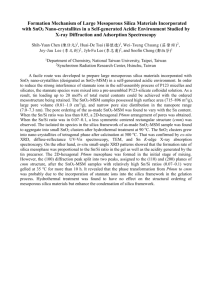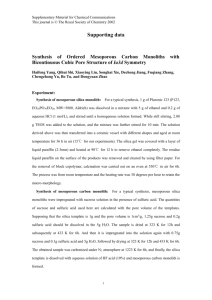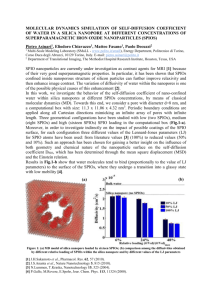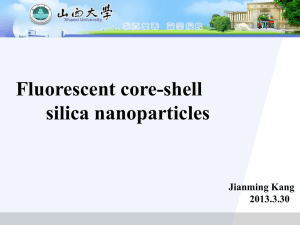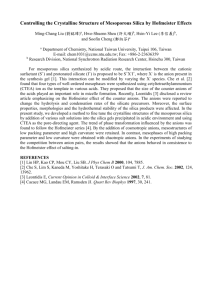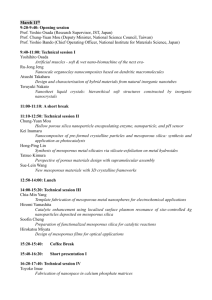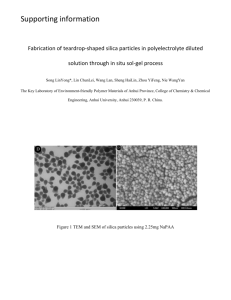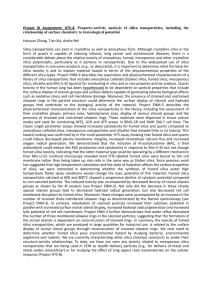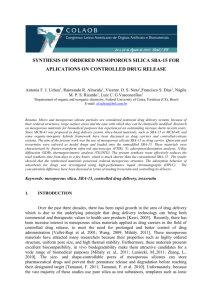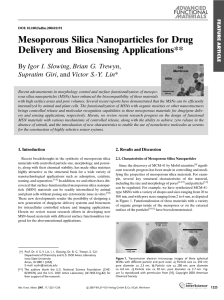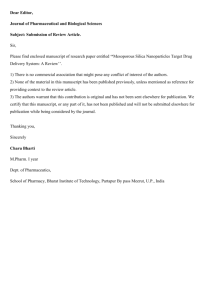supporting-information_L14-01977R1
advertisement
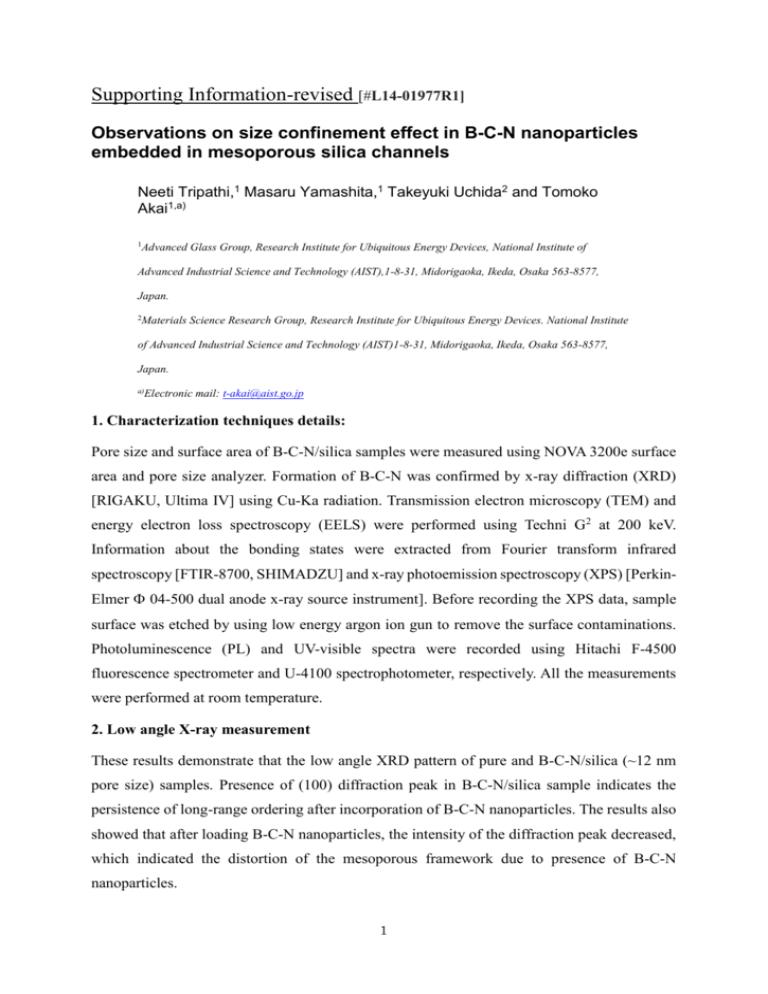
Supporting Information-revised [#L14-01977R1] Observations on size confinement effect in B-C-N nanoparticles embedded in mesoporous silica channels Neeti Tripathi,1 Masaru Yamashita,1 Takeyuki Uchida2 and Tomoko Akai1,a) 1Advanced Glass Group, Research Institute for Ubiquitous Energy Devices, National Institute of Advanced Industrial Science and Technology (AIST),1-8-31, Midorigaoka, Ikeda, Osaka 563-8577, Japan. 2Materials Science Research Group, Research Institute for Ubiquitous Energy Devices. National Institute of Advanced Industrial Science and Technology (AIST)1-8-31, Midorigaoka, Ikeda, Osaka 563-8577, Japan. a)Electronic mail: t-akai@aist.go.jp 1. Characterization techniques details: Pore size and surface area of B-C-N/silica samples were measured using NOVA 3200e surface area and pore size analyzer. Formation of B-C-N was confirmed by x-ray diffraction (XRD) [RIGAKU, Ultima IV] using Cu-Ka radiation. Transmission electron microscopy (TEM) and energy electron loss spectroscopy (EELS) were performed using Techni G2 at 200 keV. Information about the bonding states were extracted from Fourier transform infrared spectroscopy [FTIR-8700, SHIMADZU] and x-ray photoemission spectroscopy (XPS) [PerkinElmer 04-500 dual anode x-ray source instrument]. Before recording the XPS data, sample surface was etched by using low energy argon ion gun to remove the surface contaminations. Photoluminescence (PL) and UV-visible spectra were recorded using Hitachi F-4500 fluorescence spectrometer and U-4100 spectrophotometer, respectively. All the measurements were performed at room temperature. 2. Low angle X-ray measurement These results demonstrate that the low angle XRD pattern of pure and B-C-N/silica (~12 nm pore size) samples. Presence of (100) diffraction peak in B-C-N/silica sample indicates the persistence of long-range ordering after incorporation of B-C-N nanoparticles. The results also showed that after loading B-C-N nanoparticles, the intensity of the diffraction peak decreased, which indicated the distortion of the mesoporous framework due to presence of B-C-N nanoparticles. 1 Figure S1: Low angle X-ray diffraction pattern for pure and B-C-N loaded mesoporous silica particle. 2. TEM image of pure silica sample: The porous structure of pure mesoporous silica particle is shown in Fig. S2. The void spaces are filled by the B-C-N nanoparticles and forming the compact structure of B-C-N/silica composite as shown in 2 (b) of the main article. Figure S2: STEM images of pure mesoporous silica particle. 2 3. X-ray photoemission spectroscopy (XPS) Figure S3 demonstrates the XPS core level spectra of B, C, N and Si elements, for the sample BCN@silica-13 nm pore size. Figure S3 (a) show the B1s spectrum, which could be deconvoluted in to two Gaussians curves with low energy component positioned at 191.4 eV and a high energy component at 193.2 eV respectively. These positions in B1s spectra attribute to the B-N and B-O bonds respectively. [1-5] Figure S3 (b) exhibits three components at positions 281.6, 284.3 and 285.5 eV, respectively for C1s spectrum. Mannan et al. [6] assigned the lower binding energy component at 282.5 eV to the C-B bond. Considering the change in the chemical environment, peak (I) can be refer to the C-B bonding.[6] Furthermore, peak (II) positioned at 284.4 eV was the same as reported for graphite structure, shows a C atom bonding with 3 C atoms. The FWHM for peak (II) (2.2 eV) is higher than that for graphite (0.25 eV), which indicates the contribution of B-C and C-N bonding other than the C atom bonding with three C atoms. Similar results obtained in case of other B-C-N compounds such as BC2N. [3] The higher energy component (III) at 285.5 eV revealed that a significant number of carbon atoms are bonded to the nitrogen.[7] The deconvolution of N 1s revealed the presence of at least two contributions at energy 397.4 eV and 398.5 eV, as shown in the Figure S3(c). Peak (I) at lower energy side is assigned to N-B bonding, whereas, peak (II) at higher energy side designated to the C-N bonding. [8] In Figure S3 (d), peak (I) at 100.8 eV is assigned to SiC, whereas peak (II) at 102.5 eV referred to SiO2.[7] XPS results support the fact that B-C-N nanoparticles formed within mesoporous silica matrix. Figure S3. XPS spectrum (a) B1s (b) C1s (c) N1s (d) Si-2p for B-C-N/silica (pore size 13 nm). 3 References [1] F. Saugnac, F. Teyssandier, A. Marchand, J. A. Ceram. Soc. 75, 161 (1992). [2] A. Weber, U. Bringmann, R. Nikulski, C. P. Klages, Diamond Relat. Mat. 2, 8 (1993). [3] M.O. Watanabe, T. Sasaki, S. Itoh, K. Mizushima, Thin Solid Film, 281-282, 334 (1996). [4] Z. F. Ying, D. Yu, H. Ling, N. Xu, Y. F. Lu, J. Sun, J.D. Wu, Diamond Relat. Mat. 16, 1579 (2007). [5] M.O. Watanabe, S. Itoh, K. Mizushima, T. Sasaki, Appl. Phys. Lett. 68, 2962 (1996). [6] M. A. Mannan, H. Noguchi, T. Kida, M. Nagano, N. Hirao, Y. Baba, Mat. Sci. Semi. Process. 11, 100 (2008). [7] M. Tabbal, P Merel, S. Moisa, M. Chaker, A. Recard, M. Moisan, Appl. Phys. Lett. 69, 1698 (1996). [8] C. D. Wagner, W. M. Riggs, L. E. Davis, J. F. Moulder, G. E. Muilenberg, Handbook of X-ray Photoelectron Spectroscopy (Perkin-Elmer, Eden Prairie, MN, 1979). 4
